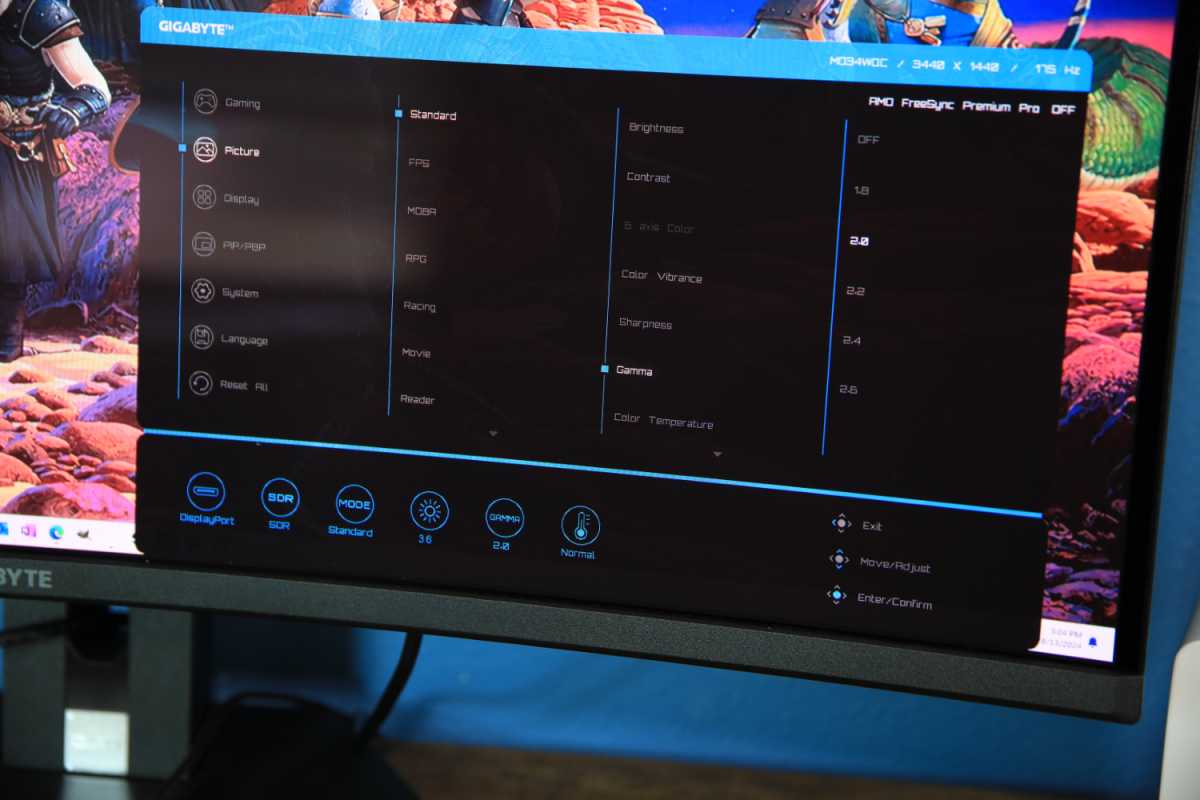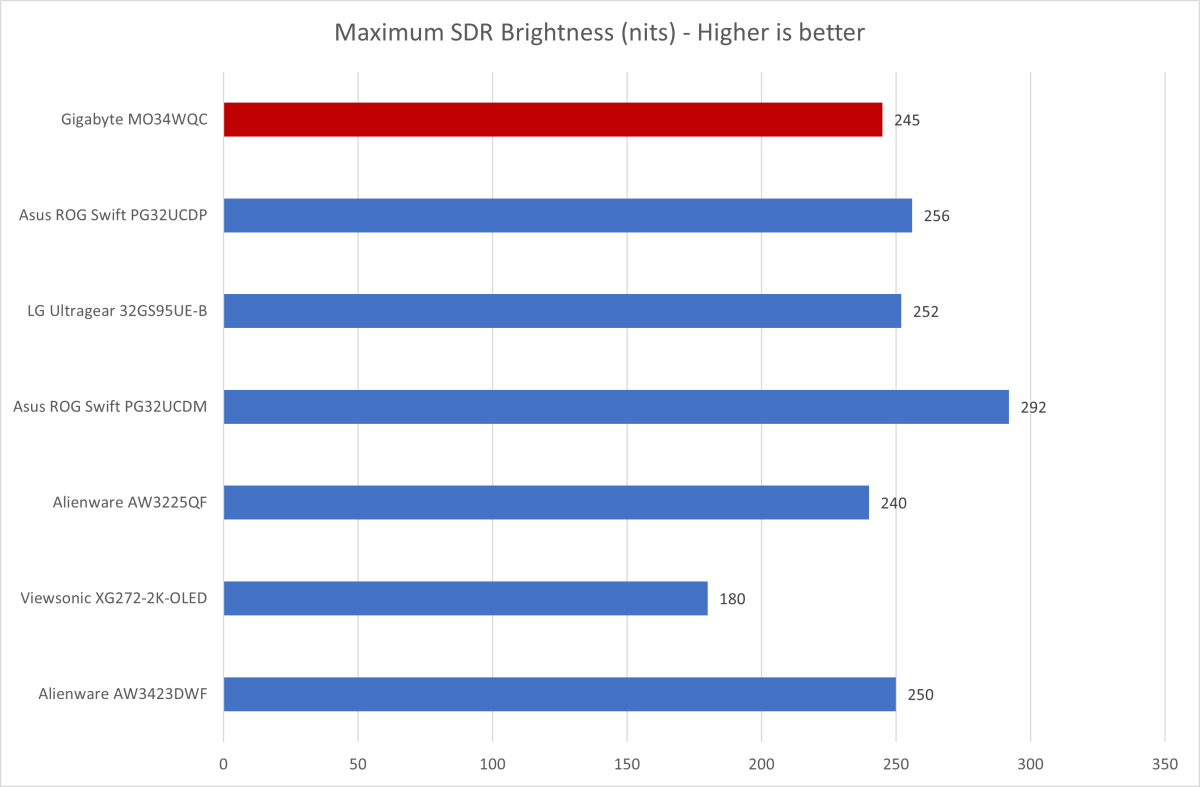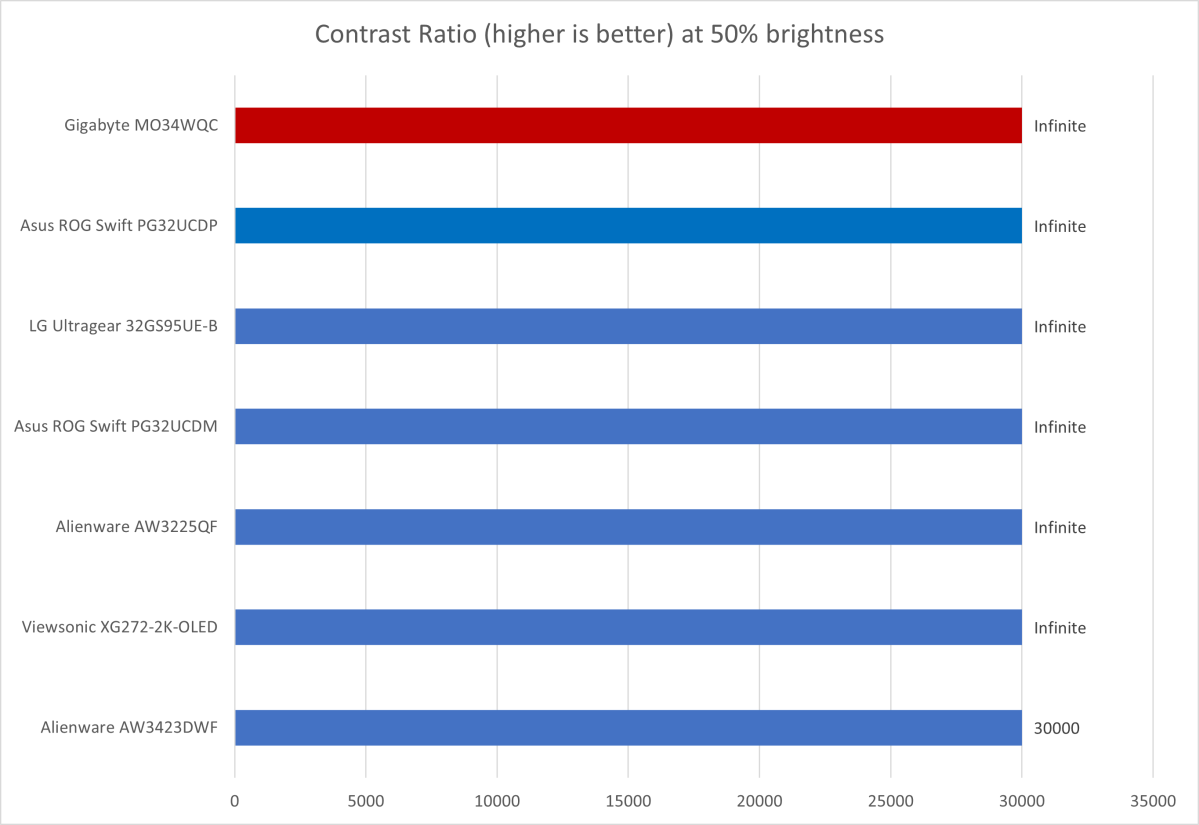Gigabyte MO34WQC review: A generically great QD-OLED monitor

 Image: Matthew Smith / Foundry
Image: Matthew Smith / FoundryAt a glance
Expert’s Rating
Pros
Immersive contrastVery wide, vivid color gamutAppealing motion clarity at 175Hz
Cons
Generic look and feelColor accuracy is a tad behind competitorsDoesn’t stand out from QD-OLED alternatives
Our Verdict
The Gigabyte MO34WQC is a generically great QD-OLED display. Unfortunately, opting for its dull design doesn’t save you any cash.
Best Prices Today: Gigabyte MO34WQC
RetailerPrice
Shoppers looking to buy a 34-inch ultrawide OLED monitor have no shortage of options this summer, and that means the details matter. Gigabyte’s MO34WQC has an OLED panel with image quality and motion clarity typical of the competition, but tries to stand out with additional USB-C and USB connectivity. While this does improve its appeal, your decision is likely to be based on its price.
Gigabyte MO34WQC specs and features
The Gigabyte MO34WQC has a Samsung QD-OLED panel with a resolution of 3440×1440 and a refresh rate of up to 175Hz. This is similar to most QD-OLED monitors on the market, but behind the latest panels, which can hit 240Hz or higher.
Gigabyte offers an alternative model, the MO34WQC2, which has a QD-OLED panel with a higher maximum refresh rate of 240Hz. It’s also more expensive with a typical retail price of $1,000. The two monitors are similar enough that Gigabyte issued the same user manual for both, but we haven’t tested the MO34WQC2 yet.
Display size: 34-inch ultrawide 21:9 aspect ratioNative resolution: 3440×1440Panel type: Anti-reflection QD-OLEDRefresh rate: Up to 175HzAdaptive sync: Adaptive Sync, AMD FreeSync Premium ProPorts: 2x HDMI 2.1, 1x DisplayPort 1.4, 1x USB-C with DisplayPort Alternate Mode and 18 watts USB Power Delivery, 2x USB-A 3.2 downstream, 1x USB-B 3.2 upstream, 1x 3.5mm headphone jack, 1x 3.5mm microphone jackVESA mount: 100x100mmSpeakers: Yes, 2x 3-watt speaker systemPrice: $949.99 MSRP, $849.99 typical retail
Panel aside, the MO34WQC’s specifications have a few highlights. The monitor features two HDMI 2.1 ports, in addition to DisplayPort and a USB-C port with DisplayPort support, for a total of four video inputs. The USB-C port also provides power, though not enough to charge a PC laptop quickly. Built-in speakers are included as well, which isn’t true of all competitors.
Further reading: See our roundup of the best monitors to learn about competing products.
Gigabyte MO34WQC design
The Gigabyte MO34WQC is sold as a gaming monitor but it’s not part of Gigabyte’s Aorus gaming sub-brand, so it delivers a more basic, workmanlike design. The front of the panel boasts slim black bezels on three sides and a small plastic chin at the bottom, while the rear of the panel is coated in black plastic that feels sturdy but looks unremarkable. The MO34WQC strikes a much more generic profile than design leaders like the Alienware AW3423DWF or Samsung Odyssey G85SB.
Gigabyte ships the monitor with an ergonomic stand that adjusts for height, tilt, and swivel. The stand has a wide base that takes up a fair bit of room on a desk, but the base is flat and not too thick, so it’s possible to place items on the space it occupies. The stand also feels sturdy and proves easy to adjust with modest effort. A 100x100mm VESA mount is available for use with a third-party monitor arm, stand, or wall mount.
The monitor is curved with a radius of 1800R, meaning the display panel would need to continue for 1,800 millimeters (about 6 feet) to form a full circle. The curve is noticeable but doesn’t draw too much attention, and most 34-inch QD-OLED monitors have settled on 1800R as the preferred curve radius for this size of monitor.


Matthew Smith / Foundry

Matthew Smith / Foundry
Matthew Smith / Foundry
Gigabyte MO34WQC design connectivity and menus
Gigabyte provides a total of four video inputs for the MO34WQC: two HDMI 2.1 ports, one DisplayPort 1.4 port, and a USB-C port, which also supports DisplayPort mode. While four video inputs are not unusual for a monitor in this price range, they do cover most use cases, and all available ports support the display’s maximum refresh rate.
The monitor also has two USB-A downstream ports, which can be driven either by the USB-C port or, if your PC lacks USB-C, through a USB-A to USB-B connection. Gigabyte includes a KVM switch function, allowing you to use the monitor as a KVM switch if you connect your wired keyboard and mouse to the monitor. The USB-C port has Power Delivery, but only up to 18 watts, which means it’s not a good choice for powering and charging a laptop with USB-C.
Gigabyte provides an intuitive and responsive joystick to control the on-screen menus. The menus themselves are large and well-organized but, despite their size, the font is still thin and a bit difficult to read. Gigabyte offers a good range of image quality options, including multiple color temperature, gamma presets, and six-axis color calibration — but that’s typical at this price point.


Matthew Smith / Foundry

Matthew Smith / Foundry
Matthew Smith / Foundry
Also typical is the monitor’s gaming features: It has a black equalizer to elevate the brightness of dark areas in games and some optional on-screen elements like a crosshair. There’s multiple aspect ratio modes, too, which emulate the size of a 24-inch or 22-inch display, as well as a 1:1 aspect ratio mode. Picture-by-picture and picture-in-picture modes are also available.
While the MO34WQC includes built-in speakers, they’re unremarkable. The maximum volume is adequate, and sound quality is clear in basic situations such as listening to podcasts. But games, movies, and other entertainment will quickly overwhelm them, resulting in muddy and unpleasant sound. External speakers or headphones are still recommended for most people.
Gigabyte MO34WQC SDR image quality
At this point, you might be sensing a theme: The Gigabyte MO34WQC is a good QD-OLED monitor, but not one that stands out from the crowd. This continues to be true when it comes to image quality. It’s a fantastic monitor for SDR content, but no more so than its QD-OLED peers.


Matthew Smith / Foundry

Matthew Smith / Foundry
Matthew Smith / Foundry
The MO34WQC’s brightness is typical for an OLED monitor, with a maximum measured sustained SDR brightness of 245 nits. This is in line with other OLED monitors and is bright enough for use in a room with moderate light control. However, the monitor might appear dim or suffer from glare if used in a room with bright, sunlit windows. In that case, no OLED monitor is a great choice, and a brighter IPS-LED or Mini-LED display would be a better fit for your environment.


Matthew Smith / Foundry

Matthew Smith / Foundry
Matthew Smith / Foundry
Unsurprisingly, contrast is excellent, with an effectively infinite contrast ratio thanks to the monitor’s ability to achieve a perfect minimum luminance of zero nits. This is a defining characteristic of modern OLED display panels, so Gigabyte has no advantage here. Still, it contributes to the monitor’s overall image quality. An OLED display panel like the one on the MO34WQC achieves a level of depth and immersion LCD monitors can’t match.


Matthew Smith / Foundry

Matthew Smith / Foundry
Matthew Smith / Foundry
Color gamut is among the MO34WQC’s best traits but, once again, it’s similar to other monitors with a Samsung QD-OLED panel.
The Gigabyte achieves 100 percent of the sRGB gamut, 98 percent of DCI-P3, and 94 percent of Adobe RGB. That’s excellent coverage of each color gamut and close to the best available from any modern monitor. Photographers, videographers, digital artists, and other content will find the MO34WQC capable of displaying a dazzling range of color.


Matthew Smith / Foundry

Matthew Smith / Foundry
Matthew Smith / Foundry
The Gigabyte MO34WQC’s color accuracy is good but technically a bit less accurate out of the box than some competitors, which might sway some shoppers towards alternatives.
Related to that, we noticed the monitor had a gamma result of 2.4, which is off the target of 2.2, and a default color temperature of 6100K, which is warmer than the target of 6500K. In general, content on the monitor looked darker and slightly warmer than it should have with the monitor at its default settings. However, calibration can help resolve the issue.
Resolution comes in at 3440×1440, which is standard for a 34-inch QD-OLED ultrawide monitor. Sharpness is good thanks to the monitor’s pixel density of about 110 pixels per inch (PPI), but QD-OLED has subpixel issues which can cause pixelation or off-color effects around high-contrast edges and small fonts. It’s rarely a problem in gaming, but the monitor’s sharpness might prove inadequate if you spend a lot of time staring at Excel spreadsheets with a 10-point font.
On balance, the Gigabyte MO34WQC’s SDR image quality is what we’ve come to expect from Samsung QD-OLED display panels in this size and resolution. The monitor benefits from an outstanding contrast ratio and an extremely wide color gamut, though its brightness is low for brighter rooms.
HDR performance is okay for most games but might not be sufficient if you plan to watch a lot of HDR movies and have a critical eye for image quality.
Gigabyte MO34WQC HDR image quality
The Gigabyte MO34WQC supports HDR and is VESA DisplayHDR True Black 400 certified. Most QD-OLED monitors have this level of certification, and while the QD-OLED panel provides some benefit in HDR content, it’s not the best available.
I measured a maximum HDR brightness of 402 nits in a 10 percent window, meaning 10 percent of the display’s total area was lit while the rest remained entirely black. This result is not particularly impressive, though it’s fairly typical for a Samsung QD-OLED panel. In contrast, LG’s newest WOLED panels, which are available in monitors like the Asus ROG Swift PG32UCDP, can achieve a much higher maximum HDR brightness; for instance, the Asus hit 731 nits in a 10 percent window.
In practice, the Gigabyte’s HDR performance is passable. HDR Highlights, like a flash of lightning or a star in the night sky, will appear reasonably bright and deliver decent luminance detail. However, there’s a noticeable reduction in luminance detail compared to an LG WOLED panel or a good Mini-LED monitor. When viewing the “Gargantua” scene from Interstellar, for example, I noticed less gradient and details to the swirling, super-heated gas surrounding the black hole. This level of HDR performance is okay for most games but might not be sufficient if you plan to watch a lot of HDR movies and have a critical eye for image quality.
Gigabyte MO34WQC motion performance
Motion clarity is a strength for the Gigabyte MO34WQC, as is true for other QD-OLED monitors. The Gigabyte offers a maximum refresh rate of 175Hz and a quoted pixel response time of 0.03 milliseconds. It also supports adaptive sync through AMD FreeSync Premium Pro, which helps improve motion fluidity.
Testing motion clarity with fast-paced games like League of Legends and DOTA 2 showed that most of the game elements were easy to view during motion. Details like character sprites and health bars remained reasonably visible, even when scrolling quickly. Yet some small details, like character names, were at times difficult to make out, especially when the text’s color didn’t contrast well with the background. This is similar to other QD-OLED monitors with refresh rates in the 160Hz to 180Hz range and close to what you can expect to find on a 240Hz IPS or VA panel monitor.
The monitor’s enhanced refresh rate is most relevant to gamers but also improves responsiveness in everyday tasks on the Windows desktop by reducing input lag and improving clarity. Viewers who are sensitive to motion clarity will notice that actions like opening and closing windows, or moving them across the desktop, look smoother and feel more fluid compared to monitors with a lower refresh rate.
Should you buy the Gigabyte MO34WQC?
The proliferation of Samsung’s excellent QD-OLED panel technology has made it difficult for monitors that use it to stand out from the crowd. It’s a bit of a catch-22 for monitor makers: They want to use QD-OLED because it’s excellent, but when everyone uses it, it’s hard for any monitor to stand out.
That’s certainly the case for the Gigabyte MO34WQC. It’s a great display for SDR content and benefits from excellent motion clarity. However, like other QD-OLED displays, it could be brighter, and sharpness can be an issue when viewing smaller fonts or other fine details.
Ultimately, your decision to buy or skip the MO34WQC should come down to the price. At the moment, it retails for $850 at most online retailers. That’s not bad but hard to recommend when competitors like the Alienware AW3423DWF are now down to $700, and even Samsung’s Odyssey G85SB is available for $800. The MO34WQC becomes a strong pick if you find it for $750 or less — a price I wouldn’t be surprised to see it hit over the holiday shopping season.
Best Prices Today: Gigabyte MO34WQC
RetailerPrice
Author: Matthew S. Smith
Matthew S. Smith is a freelance technology journalist with 15 years of experience reviewing consumer electronics. In addition to PCWorld, his work can be found on Wired, Ars Technica, Digital Trends, Reviewed, IGN, and Lifewire. Matthew also covers AI and the metaverse for IEEE Spectrum and runs Computer Gaming Yesterday, a YouTube channel devoted to PC gaming history.
Recent stories by Matthew S. Smith:
Best USB-C monitors 2024: These displays have a hidden talentBest 4K monitors 2024: HDR, 144Hz, budget, and best overallBest portable monitors 2024: Displays that go with you




